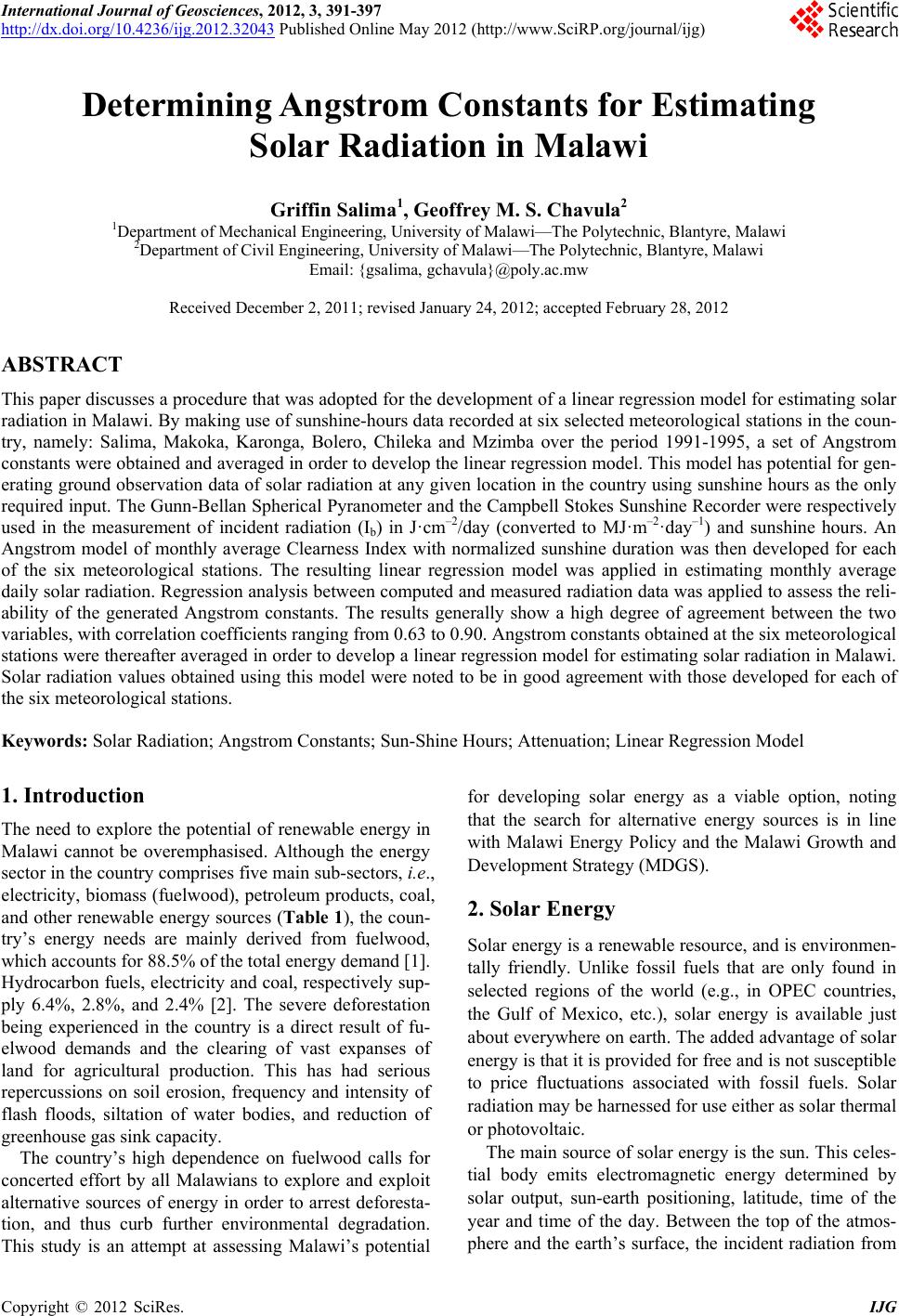
International Journal of Geosciences, 2012, 3, 391-397
http://dx.doi.org/10.4236/ijg.2012.32043 Published Online May 2012 (http://www.SciRP.org/journal/ijg)
Determining Angstrom Constants for Estimating
Solar Radiation in Malawi
Griffin Salima1, Geoffrey M. S. Chavula2
1Department of Mechanical Engineering, University of Malawi—The Polytechnic, Blantyre, Malawi
2Department of Civil Engineering, University of Malawi—The Polytechnic, Blantyre, Malawi
Email: {gsalima, gchavula}@poly.ac.mw
Received December 2, 2011; revised January 24, 2012; accepted February 28, 2012
ABSTRACT
This paper discusses a procedure that was adopted for the development of a linear regression model for estimating solar
radiation in Malawi. By making use of sunshine-hours data recorded at six selected meteorological stations in the coun-
try, namely: Salima, Makoka, Karonga, Bolero, Chileka and Mzimba over the period 1991-1995, a set of Angstrom
constants were obtained and averaged in order to develop the linear regression model. This model has potential for gen-
erating ground observation data of solar radiation at any given location in the country using sunshine hours as the only
required input. The Gunn-Bellan Spherical Pyranometer and the Campbell Stokes Sunshine Recorder were respectively
used in the measurement of incident radiation (Ib) in J·cm–2/day (converted to MJ·m–2·day–1) and sunshine hours. An
Angstrom model of monthly average Clearness Index with normalized sunshine duration was then developed for each
of the six meteorological stations. The resulting linear regression model was applied in estimating monthly average
daily solar radiation. Regression analysis between computed and measured radiation data was applied to assess the reli-
ability of the generated Angstrom constants. The results generally show a high degree of agreement between the two
variables, with correlation coefficients ranging from 0.63 to 0.90. Angstrom constants obtained at the six meteorological
stations were thereafter averaged in order to develop a linear regression model for estimating solar radiation in Malawi.
Solar radiation values obtained using this model were noted to be in good agreement with those developed for each of
the six meteorological stations.
Keywords: Solar Radiation; Angstrom Constants; Sun-Shine Hours; Attenuation; Linear Regression Model
1. Introduction for developing solar energy as a viable option, noting
that the search for alternative energy sources is in line
with Malawi Energy Policy and the Malawi Growth and
Development Strategy (MDGS).
The need to explore the potential of renewable energy in
Malawi cannot be overemphasised. Although the energy
sector in the country comprises five main sub-sectors, i.e.,
electricity, biomass (fuelwood), petroleum products, coal,
and other renewable energy sources (Table 1 ), the coun-
try’s energy needs are mainly derived from fuelwood,
which accounts for 88.5% of the total energy demand [1].
Hydrocarbon fuels, electricity and coal, respectively sup-
ply 6.4%, 2.8%, and 2.4% [2]. The severe deforestation
being experienced in the country is a direct result of fu-
elwood demands and the clearing of vast expanses of
land for agricultural production. This has had serious
repercussions on soil erosion, frequency and intensity of
flash floods, siltation of water bodies, and reduction of
greenhouse gas sink capacity.
2. Solar Energy
Solar energy is a renewable resource, and is environmen-
tally friendly. Unlike fossil fuels that are only found in
selected regions of the world (e.g., in OPEC countries,
the Gulf of Mexico, etc.), solar energy is available just
about everywhere on earth. The added advantage of solar
energy is that it is provided for free and is not susceptible
to price fluctuations associated with fossil fuels. Solar
radiation may be harnessed for use either as solar thermal
or photovoltaic.
The main source of solar energy is the sun. This celes-
tial body emits electromagnetic energy determined by
solar output, sun-earth positioning, latitude, time of the
year and time of the day. Between the top of the atmos-
phere and the earth’s surface, the incident radiation from
The country’s high dependence on fuelwood calls for
concerted effort by all Malawians to explore and exploit
alternative sources of energy in order to arrest deforesta-
tion, and thus curb further environmental degradation.
This study is an attempt at assessing Malawi’s potential
C
opyright © 2012 SciRes. IJG